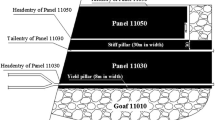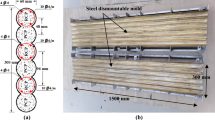Abstract
Standing supports have been used in coal mines for decades to enhance roof support capability. Sometimes standing supports are used as a tool to resist the lateral movement of spalled ribs. Researchers from the National Institute for Occupational Safety and Health (NIOSH) are conducting a testing program for different types of standing supports (steel and timber) to investigate the effect of lateral loading on their vertical loading capacities and the factors affecting their lateral loading capacities. In this paper, the mine roof simulator (MRS), at the NIOSH Pittsburgh research facility, was used to determine the response of steel props to vertical and horizontal loadings. Finite element models (FEMs) were developed and verified using the tested steel props. To justify the testing program for testing standing supports with end-conditions of rock-like materials, the verified prop models were used to study the effect of a wide range of roof and floor materials (gray shale, shale, and claystone) on the critical buckling loads of the steel props. Also, several lateral loading scenarios were evaluated in which the steel props were laterally loaded at different heights. The critical buckling load for steel props setting up against a claystone roof and floor was found to be one-half of that shown by the MRS test where roof and floor platens are made of steel. Minimum prop performance was observed when the lateral load was applied at the mid-height of the steel prop, especially at small lateral displacement (less than 2 in).













Similar content being viewed by others
References
MSHA (2019) Accident, illness and injury and employment self-extracting files (part 50 data), 2010–2019. https://arlweb.msha.gov/STATS/PART50/p50y2k/AETABLE.HTM
MSHA (2013) Roof control plan approval handbook
Mohamed KM, Murphy MM, Lawson HE, Klemetti T (2016) Analysis of the current rib support practices and techniques in U.S. coal mines. Int J Min Sci Technol 26:77–87
MSHA (2012) Report of investigations. Fatal rib roll accident. CAI-2012–04
MSHA (2010) Report of investigation. Fall of roof/rib. CAI-2010–38
Barczak TM, Tasillo CL (1988) Factors affecting the strength and stability of wood cribbing: height, configuration, and horizontal displacement. U.S. Department of Interior, Bureau of Mines, RI 9168, 23 p
Barczak TM (1988) An overview of standing roof support practices and developments in the United States. Proceedings of the Third South African Rock Engineering Symposium, Johannesburg, Republic of South Africa: S Afr Inst Min Metall October 10–12, 2005:301–334
Barczak TM and Tasillo Carol L (1988) Factors affecting strength and stability of wood cribbing: height, configuration, and horizontal displacement. Report of investigations (United States Bureau of Mines), 9168
Mohamed KM, Xue Y, Rashed G, Kimutis R (2021) Analyzing rib stability and support using a coal pillar rib rating. In: 40th International Conference on Ground Control in Mining. Canonsburg, PA, USA
Nargund S and Williams DK (2016) Review and comparison of buckling methodologies for ASME B&PV code, section III, subsection NF linear piping restraints. Downloaded From: http://proceedings.asmedigitalcollection.asme.org/. Accessed 11/13/2017
ANSYS (2020) Documentation for ANSYS, release 20. ANSYS Inc., Canonsburg, PA
Zipf RK (2007) Numerical modeling procedures for practical coal mine design. In: Proceedings of the International Workshop on Rock Mass Classification in Underground Mine Design. National Institute for Occupational Safety and Health, NIOSH IC 9498.
Author information
Authors and Affiliations
Corresponding author
Ethics declarations
Disclaimer
The findings and conclusions in this study are those of the authors and do not necessarily represent the official position of the National Institute for Occupational Safety and Health (NIOSH), Centers for Disease Control and Prevention. Mention of any company or product does not constitute endorsement by NIOSH.
Conflict of Interest
The authors declare no competing interests.
Additional information
Publisher's Note
Springer Nature remains neutral with regard to jurisdictional claims in published maps and institutional affiliations.
Rights and permissions
About this article
Cite this article
Mohamed, K., Batchler, T. Analysis of Steel Prop Supports Subjected to Vertical and Lateral Loading. Mining, Metallurgy & Exploration 39, 2001–2010 (2022). https://doi.org/10.1007/s42461-022-00673-2
Received:
Accepted:
Published:
Issue Date:
DOI: https://doi.org/10.1007/s42461-022-00673-2




